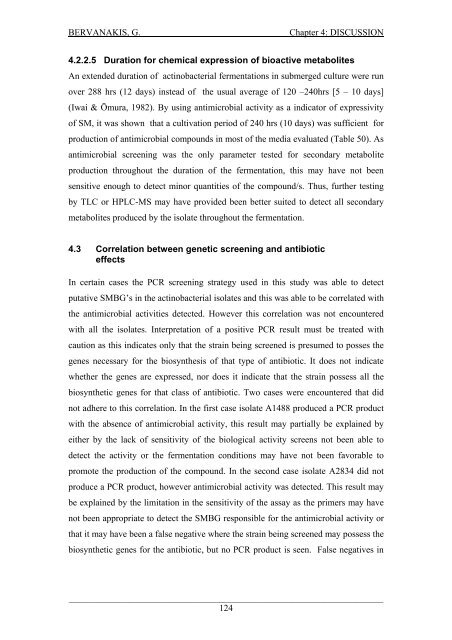Detection and Expression of Biosynthetic Genes in Actinobacteria ...
Detection and Expression of Biosynthetic Genes in Actinobacteria ...
Detection and Expression of Biosynthetic Genes in Actinobacteria ...
You also want an ePaper? Increase the reach of your titles
YUMPU automatically turns print PDFs into web optimized ePapers that Google loves.
BERVANAKIS, G.Chapter 4: DISCUSSION4.2.2.5 Duration for chemical expression <strong>of</strong> bioactive metabolitesAn extended duration <strong>of</strong> act<strong>in</strong>obacterial fermentations <strong>in</strong> submerged culture were runover 288 hrs (12 days) <strong>in</strong>stead <strong>of</strong> the usual average <strong>of</strong> 120 –240hrs [5 – 10 days](Iwai & Ōmura, 1982). By us<strong>in</strong>g antimicrobial activity as a <strong>in</strong>dicator <strong>of</strong> expressivity<strong>of</strong> SM, it was shown that a cultivation period <strong>of</strong> 240 hrs (10 days) was sufficient forproduction <strong>of</strong> antimicrobial compounds <strong>in</strong> most <strong>of</strong> the media evaluated (Table 50). Asantimicrobial screen<strong>in</strong>g was the only parameter tested for secondary metaboliteproduction throughout the duration <strong>of</strong> the fermentation, this may have not beensensitive enough to detect m<strong>in</strong>or quantities <strong>of</strong> the compound/s. Thus, further test<strong>in</strong>gby TLC or HPLC-MS may have provided been better suited to detect all secondarymetabolites produced by the isolate throughout the fermentation.4.3 Correlation between genetic screen<strong>in</strong>g <strong>and</strong> antibioticeffectsIn certa<strong>in</strong> cases the PCR screen<strong>in</strong>g strategy used <strong>in</strong> this study was able to detectputative SMBG’s <strong>in</strong> the act<strong>in</strong>obacterial isolates <strong>and</strong> this was able to be correlated withthe antimicrobial activities detected. However this correlation was not encounteredwith all the isolates. Interpretation <strong>of</strong> a positive PCR result must be treated withcaution as this <strong>in</strong>dicates only that the stra<strong>in</strong> be<strong>in</strong>g screened is presumed to posses thegenes necessary for the biosynthesis <strong>of</strong> that type <strong>of</strong> antibiotic. It does not <strong>in</strong>dicatewhether the genes are expressed, nor does it <strong>in</strong>dicate that the stra<strong>in</strong> possess all thebiosynthetic genes for that class <strong>of</strong> antibiotic. Two cases were encountered that didnot adhere to this correlation. In the first case isolate A1488 produced a PCR productwith the absence <strong>of</strong> antimicrobial activity, this result may partially be expla<strong>in</strong>ed byeither by the lack <strong>of</strong> sensitivity <strong>of</strong> the biological activity screens not been able todetect the activity or the fermentation conditions may have not been favorable topromote the production <strong>of</strong> the compound. In the second case isolate A2834 did notproduce a PCR product, however antimicrobial activity was detected. This result maybe expla<strong>in</strong>ed by the limitation <strong>in</strong> the sensitivity <strong>of</strong> the assay as the primers may havenot been appropriate to detect the SMBG responsible for the antimicrobial activity orthat it may have been a false negative where the stra<strong>in</strong> be<strong>in</strong>g screened may possess thebiosynthetic genes for the antibiotic, but no PCR product is seen. False negatives <strong>in</strong>_____________________________________________________________________124















